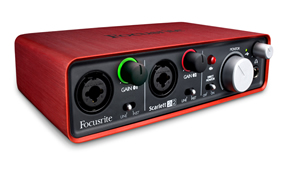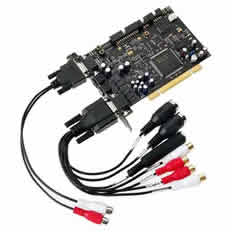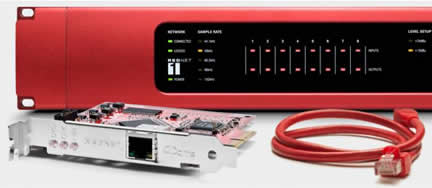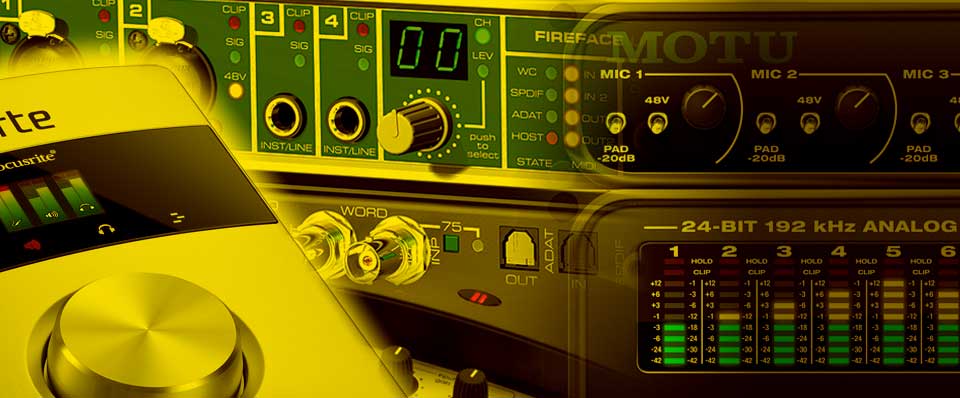There are currently 4 primary multichannel interface audio technologies for computers ..
- USB
- PCI-express
- Ethernet
- FireWire
Note: At the time of writing no Thunderbolt (USB3/4) enabled devices are available but we can expect these to appear soon and they will be the preferred choice.
Focusrite Scarlett USB 2 audio interface

USB
USB is cheap and universally implemented on desktops and laptops, and in general offers adequate performance. It can transfer high quality PCM audio comparable with professional systems, although many devices feature components such as mic pre-amps and analogue to digital converters that may not compare well with FireWire, Ethernet or PCI devices.
The USB protocol it is reliant on an operating system layer (driver software) which does not prioritise audio. Therefore latency performance may be inferior to other interface protocols, and drop-outs are possible. A professional would never reply on USB. Also, you will want to avoid USB 1 and ensure your audio interface is at least USB 2 compliant, as should your computer be.
RME PCI interface with audio breakout cables

PCI-express
Installing a PCI audio card into a desktop computer which contains converters and interfaces directly to analogue audio (usually via a break-out cable), or via a bespoke cable to some kind of hardware device equipped with converters and connectors, is a tried and tested way of ensuring reliable and professional performance. Companies like RME offers high quality PCI based audio interfaces and Pro Tools uses this arrangement too. PCI has been the most reliable solution for professional audio for many years but it is not always cheap.
FireWire
FireWire has been a popular interconnect technology for audio devices for some years, despite USB 2 and 3 offering similar or greater bandwidth (data transfer speeds). FireWire was developed for DV video transfer, and is robust and still considered a superior interconnect technology to USB.
FireWire comes in 2 favours (400 and 800) and both can accommodate fast data transfer of (theoretically) up to 64 channels of digital audio. Also, a 400 device can be connected to an 800 bus with no problems.
FireWire is not always considered a suitably robust enough technology for professional recording studios, but for home and project studios it is ideal, and it is certainly capable of professional results. Here are some advantages ..
- multi-channel counts
- low latency with a fast (multi-core) host computer
- simple interconnection
- relatively cost effective
- wide range of available devices
... and disadvantages ..
- latency performance is heavily dependant on host computer CPU performance, and even at its best (eg 64 samples) does not always compare favourably with optimised PCI and Ethernet systems. A multi-core CPU is recommended for the lowest latencies.
- the interconnect plug and socket is not robust and does not secure with a screw or latch system.
Advantage over USB
A single FireWire connection ('bus') contains 2 'sub-buses'.
- Asynchronous
- Isochronous
Asynchronous
This sub-bus transfers non-audio data. Data transferred on this sub-bus is NOT prioritised and can suffer drop-outs if the total bandwidth demand is too great. The Asynchronous sub-bus is used for things like ..
- control data
- data from a remote control
- mixing data
- plug-in data transfer (eg TC Electronics’s PowerCore)
- MIDI data
- etc
Isochronous
Data on this sub-bus IS prioritised so it is usually used for real time audio data transfer (eg recording and playback). Most FireWire audio interfaces use the Isochronous sub-bus for audio.
The Isochronous sub-bus can contain multiple sub-sub-buses or 'streams', typically 4 streams or more. Each stream can transfer multiple channels of high quality audio (typically 16 channels of 48Khz, 24-bit). Audio interfaces which offer 32 or more channels will use 2 or more streams.
Using multiple devices
Unless multiple devices are connected to the same FireWire bus, it is unusual for audio drop-outs to occur. The Asynchronous stream will always drop-out first. Best practice is to connect each device to a separate FireWire bus. This simply requires installation of additional PCI express FireWire interfaces in the computer.
Note: If your computer has 2 FireWire ports/connections/sockets built-in, they almost certainly are sharing the same bus.
TC Electronic Studio Konnekt 48 FireWire audio interface

FireWire shelf life
There has been no development or implementation of improved FireWire protocols for years and it appears that it will not survive for much longer. FireWire's decline has more to do with the rise of video camcorders which record direct to SD card than any perceived inadequacies with FireWire's performance. SD card slot, USB 2 and Thunderbolt appear to be the current favoured interface options for PCs and Macs.
However, if you tower computer doesn't have FireWire ports, you should still be able to buy a third party PCI FireWire card for some years to come. Also, we can no longer expect new laptops and all-in-one desktops to have built-in FireWire ports, and there’s no practical way to add them to these devices.
Another important issue to consider is how long a legacy interface will be supported in terms of driver updates for new computer operating systems. However, to some extent this applies to any digital audio system that pairs hardware with software running on a host Windows or Mac computer. In recent years we have seen support end for these systems ..
- TC Electronics PowerCore
- SSL Duende
- Native Instruments Kore
Focusrite Rednet audio over ethernet audio networking technology

Ethernet
Audio over IP is becoming an increasingly popular method for audio networks, and professionals in live sound have already adopted it. Audio over IP is a thoroughly professional solution that dispenses with the need for expensive multi-core analogue cable runs in the studio and concert hall.
By leveraging existing standard Ethernet protocols and connections (CAT5, CAT6 cables, switches, ethernet ports etc), and a specialist software "layer" (eg Audiantes Dante "protocol"), Audinate and a variety of established manufactures (eg Focusrite, Yamaha) have developed ethernet enabled hardware (PCI cards, mixers, hardware rack converters and stage boxes etc) which can be combined together to create hi-speed audio networks.
Focusrite's Rednet range, for example, includes ..
- 8 and 16 channel bi-directional A to D and D to A converters
- a 32 channel bi-directional digital i/o interface
- an 8 channel mic pre / A to D
- a ProTools bridge
If an analogue to digital to ethernet device is placed close to performers in a studio or on a stage, multiple channels of high quality digital audio (eg 512 channels) can be transferred 100s of meters to a recording device (eg DAW) or mixer/PA system with extremely low latencies over a single CAT5 or 6 cable. This hugely simplifies installation and live sound cabling.
Advantages include ..
- scalable - you can add more devices to the same network to produce massive channel counts
- long shelf life - uses an established interconnect technology which is unlikely to disappear anytime soon
- extremely low latency possible, often measured in micro-seconds
- cost effective cabling for both studio and live sound networks
- can work with or without a bespoke PCI express Ethernet cards, although the best latency will be achieved with a bespoke card
- long cable runs - Ethernet cables can be hundreds of metres long
Further reading
Latency in digital audio systems

